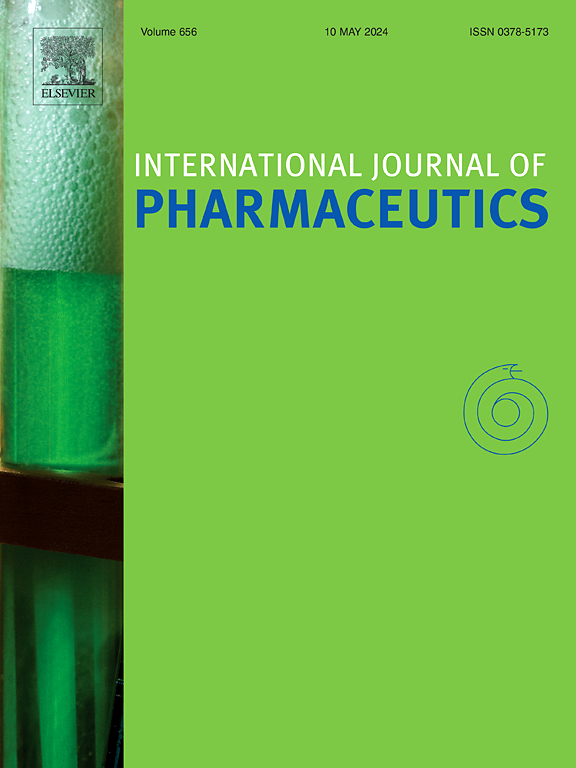Gastroretentive fibrous dosage forms for prolonged delivery of sparingly-soluble tyrosine kinase inhibitors. Part 1: Dosage form design, and models of expansion, post-expansion mechanical strength, and drug release
IF 5.3
2区 医学
Q1 PHARMACOLOGY & PHARMACY
引用次数: 0
Abstract
At present, the efficacy and safety of many cancer therapies employing a sparingly-soluble tyrosine kinase inhibitor (TKI) are compromised by excessive fluctuations in the drug concentration in blood. To mitigate this limitation, in this four-part study expandable, gastroretentive fibrous dosage forms that deliver drug into the gastric fluid (and into the blood) at a controlled rate for prolonged time are presented. The dosage form comprises a cross-ply structure of water-absorbing, high-molecular-weight hydroxypropyl methylcellulose (HPMC) based fibers coated with a strengthening, enteric excipient. The intervening spaces between the coated fibers are solid annuli of dispersed drug particles in a low-molecular-weight HPMC-based excipient matrix. The central regions of the annuli are open channels. In this part, models are developed for dosage form expansion, post-expansion mechanical strength, and drug release. The models suggest that upon immersing in a dissolution fluid, the fluid percolates the open channels, diffuses into the annuli and the coated fibers, and the dosage form expands. The expansion rate is inversely proportional, and the post-expansion mechanical strength proportional to the volume fraction of the coating. Drug particles are released from the annuli as the surrounding excipient dissolves. The drug release rate is proportional to the concentration of low-molecular-weight HPMC at the annulus/dissolution fluid interface. The dosage forms can be readily designed for expansion in a few hours, formation of a high-strength viscoelastic mass, and drug release at a constant rate over a day.

用于延长稀溶性酪氨酸激酶抑制剂给药时间的胃肠保留纤维剂型。第 1 部分:剂型设计以及膨胀、膨胀后机械强度和药物释放模型。
目前,许多稀溶性酪氨酸激酶抑制剂(TKIs)的疗效和安全性因血液中药物浓度的过度波动而受到影响。为了缓解这一限制,本研究分四部分介绍了可将药物以可控速率长时间输送到胃液(和血液)中的胃黏膜纤维剂型。这种剂型由可膨胀、吸水、高分子量的羟丙基甲基纤维素(HPMC)纤维交叉层状结构组成,表面涂有强化肠道赋形剂。涂层纤维之间的空隙是由药物颗粒、低分子量 HPMC 和肠道辅料组成的固体环状结构。环形结构的中心区域为开放通道。在这一部分中,建立了关于剂型膨胀、膨胀后机械强度和药物释放的模型。这些模型表明,在溶解液中浸泡后,溶液会渗入开放通道,扩散到环状结构和包衣纤维中,从而使剂型膨胀。膨胀率与强化涂层的厚度成反比,膨胀后的机械强度与强化涂层的厚度成正比。随着周围辅料的溶解,药物颗粒从环形结构中释放出来。药物释放率与环状体/溶解液界面上低分子量 HPMC 的浓度成正比。这种剂型设计简便,可在几小时内膨胀,形成高强度粘弹性团块,并在一天内以恒定的速度释放药物。
本文章由计算机程序翻译,如有差异,请以英文原文为准。
求助全文
约1分钟内获得全文
求助全文
来源期刊
CiteScore
10.70
自引率
8.60%
发文量
951
审稿时长
72 days
期刊介绍:
The International Journal of Pharmaceutics is the third most cited journal in the "Pharmacy & Pharmacology" category out of 366 journals, being the true home for pharmaceutical scientists concerned with the physical, chemical and biological properties of devices and delivery systems for drugs, vaccines and biologicals, including their design, manufacture and evaluation. This includes evaluation of the properties of drugs, excipients such as surfactants and polymers and novel materials. The journal has special sections on pharmaceutical nanotechnology and personalized medicines, and publishes research papers, reviews, commentaries and letters to the editor as well as special issues.

 求助内容:
求助内容: 应助结果提醒方式:
应助结果提醒方式:


